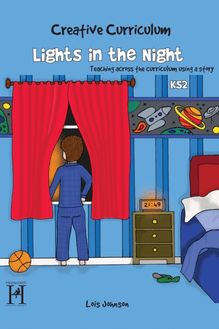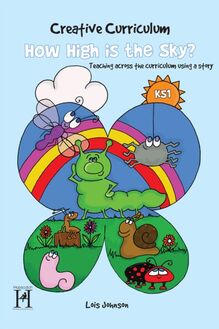Creative Curriculum KS2 , livre ebook
87
pages
English
Ebooks
2012
Vous pourrez modifier la taille du texte de cet ouvrage
Obtenez un accès à la bibliothèque pour le consulter en ligne En savoir plus
Découvre YouScribe en t'inscrivant gratuitement
Découvre YouScribe en t'inscrivant gratuitement
87
pages
English
Ebooks
2012
Vous pourrez modifier la taille du texte de cet ouvrage
Obtenez un accès à la bibliothèque pour le consulter en ligne En savoir plus
Publié par
Date de parution
12 septembre 2012
Nombre de lectures
0
EAN13
9781909102125
Langue
English
Poids de l'ouvrage
4 Mo
Publié par
Date de parution
12 septembre 2012
Nombre de lectures
0
EAN13
9781909102125
Langue
English
Poids de l'ouvrage
4 Mo
Title page
Creative Curriculum KS2
Lights in the Night
Teaching across the curriculum using a story
Lois Johnson
Copyright page
Published by Hopscotch, a division of MA Education, St Jude’s Church, Dulwich Road, London, SE24 0PB
www.hopscotchbooks.com
020 7738 5454
© 2011 MA Education Ltd
Written by Lois Johnson
Designed by Claire White, Fonthill Creative, 01722 717029
Front cover and illustrations by Kerry Bailey
2012 digital version by Andrews UK Limited
All rights reserved. This resource is sold subject to the condition that it shall not, by way of trade or otherwise, be lent, hired out or otherwise circulated without the publisher’s prior consent in any form of binding or cover other than that in which it is published and without a similar condition, including this condition, being imposed upon the subsequent purchaser.
No part of this publication may be reproduced, stored in a retrieval system, or transmitted, in any form or by any means, electronic, mechanical, photocopying, recording or otherwise, without the prior permission of the publisher, except where photocopying for educational purposes within the school or other educational establishment that has purchased this book is expressly permitted in the text.
Every effort has been made to trace the owners of copyright of material in this book and the publisher apologises for any inadvertent omissions. Any persons claiming copyright for any material should contact the publisher who will be happy to pay the permission fees agreed between them and who will amend the information in this book on any subsequent reprint.
Introduction
Creative Curriculum is an innovative, highly adaptable resource aimed at encouraging the development of a creative approach to primary teaching. The concept behind the Creative Curriculum teachers’ guides is that stories can and should offer an exciting stimulus to a range of learning opportunities. A creative curriculum makes learning fun, relevant and purposeful. A stimulating story, accessible on different levels, accommodates a variety of learning styles and enhances understanding, interaction and most importantly, enjoyment.
There are currently two books in the Creative Curriculum series:
How High is the Sky? - for ages 5-7
Lights in the Night - for ages 8-12
How High is the Sky? focuses on a rhyming story about a caterpillar who ultimately finds the answer to his question, ‘How high is the sky?’ It is a story about self-confidence , change , growth and achievement .
Lights in the Night focuses on a story written in short chapters. It follows the adventures of two friends as they attempt to solve a mystery. It is an adventure story about friendship and perseverance .
In each book the story itself is at the core of all the associated activities, thus ensuring continuity and relevance to learning by creatively using connections within and between subjects as opposed to teaching subjects individually.
This system encourages a truly cross-curricular, creative approach to teaching, offering more natural opportunities for a range of learning experiences.
The books in the Creative Curriculum series are divided into four sections: Section 1 -The Story Section 2 - The Units and worksheets Section 3 - General resource sheets Section 4 - A set of story illustrations for extension activities
The books contain ‘units’ which can be combined and used flexibly to produce sessions lasting a morning, a full day or a week making the resource completely adaptable. The units in both books cover: Literacy Numeracy Science PSHE Art/Design Music/Dance/Drama
It is suggested that Literacy Unit 1 should be the first unit used as this unit introduces the children to the text, but subsequently the units can be combined in any order or sequence. The story can be retold when introducing other units and combinations of units as often as required.
How to use this book
Section 1: The story
Lights in the Night is written in six short chapters and includes several black and white illustrations.
This story features Michael and his friend Jack. One night, Michael sees a mysterious light moving across the fields outside his house and resolves to find out what is happening and enlists his friend to help him. The story follows Michael and Jack on their adventure as they attempt to solve the mystery of who or what is making the light shine so late at night. They consider various possibilities such as alien spaceships and burglars before discovering the real culprit is someone they hadn’t suspected at all.
Section 2: The Units and worksheets
This book contains: 12 Literacy Units 5 Numeracy Units 4 Science Units 5 PSHE Units 6 Art/Design Units 4 Music/Dance/Drama Units
Literacy Unit 1 introduces the text Lights in the Night therefore it is recommended that teachers start by using this unit, which can be followed by any combination and number of units as preferred, for example:
Literacy Unit 8 looks at what you would see and hear in a storm. This could be followed by Art & Design Unit 2 which explores different ways of depicting a storm through art and Music/Dance/Drama Unit(s) 1 and/or 2 which look at the sounds of a storm and the way a storm could be shown through dance.
A further example of combining the units is to focus on a particular aspect of the story such as when Michael thinks the lights could be connected to sightings of aliens. Thus: Literacy Unit 5, Science Unit 3, PSHE Unit 3 and Art & Design Unit 6 could be combined with aliens as the theme.
Section 3: General resources
A selection of additional resources is provided for planning, noting down additional activities and to monitor learning and progression. These include: A planning-sheet to assist teachers record the units used and in which combinations. A general ‘Notes’ sheet that can be used to plan children’s groups, follow-up activities etc. Plus, as the units are used, other ideas can be incorporated to make a more personal resource and these ideas can be recorded for future reference. A ‘Today I learned’ sheet for the children to complete as required, which will encourage them to work collaboratively with their teachers and offers opportunities for assessment.
If this resource is used over a period of time, the children’s sheets could be made into booklets to keep as a record of all they have achieved, with each child creating their own front cover. A resource they will treasure!
Section 1: The Story Text
Lights in the Night
Chapter 1: The Silent Storm
Michael snuggled his head deeper into the pillow and counted, ‘One ... two ... three ... fourteen ... fifteen ... sixteen ...’ But there was still no bang.
Where was the thunder? He’d seen the flash of lightning even though his eyes were closed. A light so bright it had shone through his curtains then straight into his eyelids. He opened his eyes, no longer sleepy and lay there staring at the ceiling, waiting, listening to the quiet.
Flash! There was the light again. A brilliant beam of light flashed in through his window, briefly lighting up the room. Michael waited. Silence. There was still no thunder but the storm must be really, really close, because the lightning was so bright.
He thought about when they’d been on holiday last year at the seaside. Late one night after a hot, muggy day, there had been a big flash of lightning. It had lit up the whole room, quickly followed by loud, deep, booming thunder. He remembered his Mum saying that if you start counting when you see the flash of lightning, then stop when you hear the thunder you know how close the storm is, but he couldn’t remember exactly how to work it out.
The thunder and lightning had lasted for ages that night, rumbling and sparking across the night sky, until finally rolling away into the distance. Even then it had left behind a huge storm that raged all night, wind tearing at the trees, rain lashing at the windows, rattling the glass.
The storm had at last died down in the early hours of the morning and they’d managed to get some sleep.
But tonight it was different. There had been lots of flashes but no thunder - not even one small rumble. Climbing out of bed, Michael went over to the window and stuck his head through the curtains. He stared out into the night, peering up at the black sky.
Nothing. No storm, no angry heavy clouds, no thunder, no lightning. It was a clear night. Everything was quiet.
Suddenly, in one of the fields at the back of the house, just beyond the end of the garden, he saw a bright flash. He looked as hard as he could, trying to see where the light had come from. He couldn’t make out any of the hedges or fences or trees. There was only blackness.
Flash! There was the light again. Then it was gone.
Flash! It was further over now, moving away, across the field towards the large pond at the far side. Flash! Just for a second, he saw a big sweeping beam of light. Then it was gone. Nothing.
Michael waited.
There was only the darkness and the silence.
After peering out for a few more minutes he decided that whatever or whoever it was had gone. His fingers felt stiff, he hadn’t realised he had been gripping the windowsill so tightly. He turned round and looked at the clock on his bedside table. 21:49 the orange figures glowed in the dark.
Who would be out in the fields so late? And why?
The next morning, as soon as he awoke, Michael rushed to open the curtains. In the bright sunshine everyt

